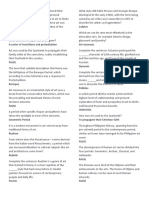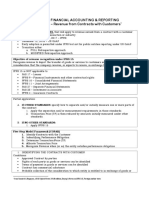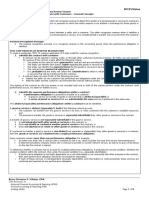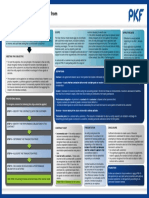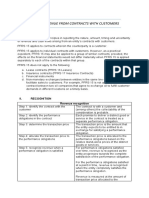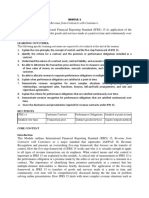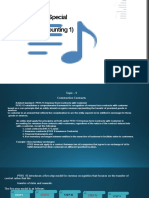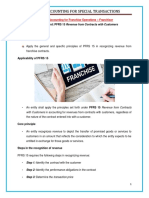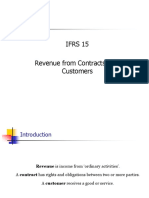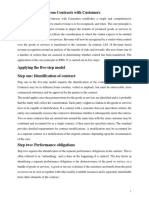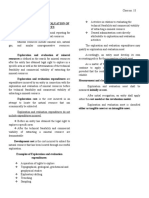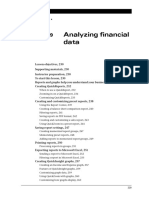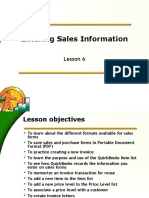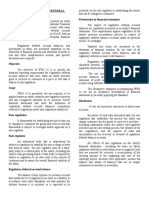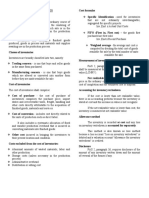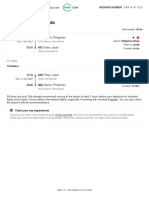Pfrs 15 - Revenue From Contracts With Customers Step 1: Identify The Contract With The Customer Contracts
Pfrs 15 - Revenue From Contracts With Customers Step 1: Identify The Contract With The Customer Contracts
Uploaded by
Ella MaeCopyright:
Available Formats
Pfrs 15 - Revenue From Contracts With Customers Step 1: Identify The Contract With The Customer Contracts
Pfrs 15 - Revenue From Contracts With Customers Step 1: Identify The Contract With The Customer Contracts
Uploaded by
Ella MaeOriginal Description:
Original Title
Copyright
Available Formats
Share this document
Did you find this document useful?
Is this content inappropriate?
Copyright:
Available Formats
Pfrs 15 - Revenue From Contracts With Customers Step 1: Identify The Contract With The Customer Contracts
Pfrs 15 - Revenue From Contracts With Customers Step 1: Identify The Contract With The Customer Contracts
Uploaded by
Ella MaeCopyright:
Available Formats
PFRS 15 - REVENUE FROM CONTRACTS WITH Step 1: Identify the contract with the customer
CUSTOMERS
Contracts
PFRS 15 is a new global framework for revenue
recognition. Agreement between two or more parties that
creates enforceable rights and obligations in a contact
Entities that sell in bundle, multiple deliverables which is under a matter of law.
or major projects could see significant change in timing
of revenue recognition. Contracts should be accounted separately.
Entities affected by new revenue standard includes Contract criteria:
businesses who are engaged in: Parties have approved the contract in writing,
Telecom orally or in accordance with customary business
Software practice.
Engineering Rights and obligations can be identified.
Construction and real estate Payment terms can be identified.
Contract has commercial substance.
Revenue The collection is probable.
Income in ordinary course of business activities Contracts should be combined as one if any of the ff.
is satisfied:
Income
Contracts are treated as single package.
Increase in economic benefit during accounting Consideration in one contract depends on goods
period in form of an inflow or enhancement of asset or or services of another contract.
decrease in liability that results in an increase in equity. Goods and services in contract relate to a single
performance obligation.
PFRS 15 applies to all contracts with customers, except:
Step 2: Identify the performance obligation
Leases under PFRS 16
Insurance contracts under PFRS 17 Performance Obligation
Financial instruments under PFRS 9
A promise to deliver goods or services in a
Core Principle contract with customers. Promise constitute obligation if
it is distinct.
An entity should recognize revenue in a manner
that depicts the pattern of transfer of good or Promised goods or service is distinct if it meets both
service to a customer. criteria:
The amount recognized as revenue should
reflect the consideration to which the entity The customer can benefit from good or service.
expects to be entitled in exchange for good or Entity's promise to transfer goods or services is
service. separately identifiable from other promises in
Revenue is recognized: contract.
At a point in time
Over time
Distinct good or service example:
Five Step Model: Sale of finished goods produced by
manufacturer
Sale of merchandise inventory by retailer Transaction price is allocated to each
Constructing, manufacturing or developing asset performance obligation on the basis of relative stand-
on behalf of customer, as in long term alone selling price.
construction contract
Granting license or franchise Determining Stand-Alone Selling Price
Performing a contractually agreed-upon task for Best evidence of stand-alone selling price is
a customer, as in bookkeeping service or payroll when goods or services is sold on stand-alone basis or
processing service. when sold separately.
Step 3: Determine transaction price If stand-alone selling price is not directly
Transaction Price observable, the entity must estimate price using the ff.
methods:
Amount of consideration in a contract to which an
entity expects to be entitled in exchange for transferring Adjusted market assessment approach - entity
good or service to a customer. may refer to prices from competitors for similar
good or service.
Adjusted for discount, rebate, price concession, Expected cost plus margin approach - entity
return, performance bonus, penalty and other similar may forecast expected cost to satisfy the
item. performance obligation adjusted for an
appropriate margin or profit.
Factors that affects transaction price: Residual approach - this may be used only
when either selling price of good or service is
Variable consideration - included when it is highly variable or uncertain. Under this method,
highly probable that significant reversal of stand-alone price is the difference between total
revenue or decrease in revenue will not occur. transaction prices and total observable stand-
Time value of money - if the contact has alone selling prices of other goods and services.
significant financing component the
consideration should adjust to time value of Step 5: Recognition of revenue
money. But if the contract is less than one year,
the entity can disregard time value of money. Control of an Asset
Difference between total consideration and cash Ability to direct the use of asset and obtain
selling price is accounted as interest income. substantially all of the benefits from the asset.
Noncash consideration - measure at FV but if
FV cannot be estimated, stand-alone selling is Entity shall recognize revenue when the entity
used. transfers control of good or service to customer.
Consideration payable to a customer - entity Revenue can be recognized either at point in time or
needs to determine if consideration payable to over time.
customer may result to reduction of transaction
price.
Example: vouchers, coupons and volume rebate
Revenue recognition at a point of time:
Step 4: Allocation of transaction price
The entity has the right to receive payment for
Stand-Alone Selling Price the asset and for which the customer is obliged
to pay
The price that an entity would sell a promised Customer has legal title to the asset
good or service separately to a customer.
Entity has transferred physical possession of the Consignor shall not recognize revenue upon
asset to the customer delivery of the goods to the consignee until the goods are
The customer has the significant risks and sold by the consignee.
rewards of ownership of the asset
The customer has accepted the asset When consigned goods are sold by consignee, a
report to called account of sales is given to the consignor
Revenue recognition over time: together with cash remittance minus commission and
other expenses chargeable against consignor.
Customer simultaneously receives and consumes
the benefits provided by the entity's performance Bill and Hold Arrangement
as the entity performs
Entity's performance creates or enhances an Contract under which an entity bills a customer
asset that customer controls as the asset is for a product but the entity retains possession of the
created or enhance. product. Revenue shall be recognized when the customer
Entity's performance does not create an asset obtains control or takes title of product.
with an alternative use to the entity and the Criteria for the recognition of revenue:
entity has an enforceable right to receive Customer has requested for arrangement
payment for performance completed to date Product must be identified separately as
belonging to customer
Sale of Goods Product must be ready for physical transfer
to the customer anytime
Revenue is recognized at the point of sale Entity cannot have the ability to use the
because the entity has transferred the significant risk and product or to direct it to another customer
reward ownership to the customer.
Customer Loyalty Program
of sale is usually point of delivery which may
be actual or constructive. Generally designed to reward customers for past
purchases and to provide them incentives to make
Sale with a Right Return further purchases.
An entity shall recognize the ff. with respect to a The entity can redeem "points" by distributing to
sale with a right of return: the customer free or discounted goods or services.
Revenue equal to the total sale price less the sale Measurement
price of the expected return
Revenue liability equal to the sale price of Revenue under time value of money is measure
expected return based on cash selling price.
Recover asset and corresponding reduction of Noncash consideration is measure at fair value.
cost of goods sold equal to the cost of the Award credits shall account as a separately
expected return component of initial sale transaction.
FC of the consideration received with respect to
initial sale shall be allocated between award
credits and sale based on relative stand-alone
Consignment Arrangement
selling price.
Consignment
Recognition
Method of marketing goods in which the entity
The consideration allocated to award credits is
called the consignor transfer physical possession of
initially recognized as deferred revenue and
certain goods to a dealer or distributor called the
subsequently recognized as revenue when the award
consignee that sells goods on behalf of the consignor.
credits are redeemed.
The amount of revenue shall be based on
number of award credits that have been redeemed
relative to total number of expected to be redeemed.
Changes in total number expected to be
redeemed do not affect the total consideration for the
award credits but changes shall be reflected in the
amount of revenue recognized in current and future
periods.
Calculation of revenue to be recognized in any
one period is made on "cumulative basis" in order to
reflect changes in estimate.
You might also like
- Art Appreciation ReviewerDocument6 pagesArt Appreciation ReviewerElla Mae100% (2)
- Notes Exercises On Pfrs 15Document13 pagesNotes Exercises On Pfrs 15Craig Julian100% (3)
- November 14, 2016Document4 pagesNovember 14, 2016KenyaReyesNo ratings yet
- Intermediate Accounting 1: a QuickStudy Digital Reference GuideFrom EverandIntermediate Accounting 1: a QuickStudy Digital Reference GuideNo ratings yet
- IFRS 15: Revenue: The UAE's Real Estate SectorDocument2 pagesIFRS 15: Revenue: The UAE's Real Estate SectorShawn WalkerNo ratings yet
- (AFAR) (S05) - PFRS 15, Installment Sales, and Consignment SalesDocument6 pages(AFAR) (S05) - PFRS 15, Installment Sales, and Consignment SalesPolinar Paul MarbenNo ratings yet
- Financial Cyber CrimeDocument10 pagesFinancial Cyber Crimebehappy_aklprasadNo ratings yet
- Chapter 34 PFRS 15 Revenue From Contracts With CustomersDocument3 pagesChapter 34 PFRS 15 Revenue From Contracts With Customersjeanette lampitocNo ratings yet
- Chapter 12 Revenue From Contracts With CustomersDocument24 pagesChapter 12 Revenue From Contracts With CustomersJane DizonNo ratings yet
- Revenue From Contracts With CustomersDocument4 pagesRevenue From Contracts With Customersmy miNo ratings yet
- Overview On PFRS 15Document2 pagesOverview On PFRS 15leetukewanNo ratings yet
- Revenue RecognitionDocument9 pagesRevenue Recognitionadmiral spongebobNo ratings yet
- Chapter 38 Revenue From Contracts With CustomersDocument10 pagesChapter 38 Revenue From Contracts With CustomersEllen MaskariñoNo ratings yet
- AFAR 03.1 - Revenue Recognition (PFRS 15)Document6 pagesAFAR 03.1 - Revenue Recognition (PFRS 15)cheoreciNo ratings yet
- Accountancy Review: Part ADocument10 pagesAccountancy Review: Part AJesa SinghbalNo ratings yet
- PUP Review Handout 2 OfficialDocument5 pagesPUP Review Handout 2 OfficialDonalyn CalipusNo ratings yet
- Ifrs 15Document12 pagesIfrs 15Zitabelle CantosNo ratings yet
- Insights On SLFRS 15 Revenue From Contracts With Customers - 1586936561 - Insights On SLFRS 1Document9 pagesInsights On SLFRS 15 Revenue From Contracts With Customers - 1586936561 - Insights On SLFRS 1AmalibuddhikaNo ratings yet
- Chap 2 Mod 1 Rev Rec Part I V2Document24 pagesChap 2 Mod 1 Rev Rec Part I V2hmaz.roid91No ratings yet
- Lecture Notes Mfrs15Document21 pagesLecture Notes Mfrs152024696498No ratings yet
- Ifrs 15 Revenue From Contracts With Customers SnapshotDocument1 pageIfrs 15 Revenue From Contracts With Customers SnapshotottieNo ratings yet
- Chapter 04 RevenueDocument16 pagesChapter 04 RevenueMuhammad IrfanNo ratings yet
- Ifrs 15: Revenue From Contracts With CustomersDocument46 pagesIfrs 15: Revenue From Contracts With CustomersHace AdisNo ratings yet
- Revenue From Contracts With Customers: Pfrs 15Document23 pagesRevenue From Contracts With Customers: Pfrs 15Marimel TizonNo ratings yet
- Ifrs 15 Revenue RecognitionDocument46 pagesIfrs 15 Revenue Recognitionesulawyer2001No ratings yet
- Ac08605 - Revenue From Contracts With CustomersDocument30 pagesAc08605 - Revenue From Contracts With CustomersWilie MichaelNo ratings yet
- Chapter 5 TextBook PP 279-309Document32 pagesChapter 5 TextBook PP 279-309Cheuk Ying NicoleNo ratings yet
- Pfrs 15 Revenue From Contracts With CustomersDocument3 pagesPfrs 15 Revenue From Contracts With CustomersR.A.No ratings yet
- IFRS 15 REVENUE RECOGNITION by DR SewaleDocument46 pagesIFRS 15 REVENUE RECOGNITION by DR Sewalegech95465195No ratings yet
- Revenue RecognitionDocument9 pagesRevenue RecognitionBerlian NovitaNo ratings yet
- IFRS-15-Revenue-from-Contracts-with-CustomersDocument16 pagesIFRS-15-Revenue-from-Contracts-with-CustomersAdnan KhanNo ratings yet
- Revenue Recognition The Change Is HereDocument8 pagesRevenue Recognition The Change Is HereVM educationzNo ratings yet
- PFRS 15Document3 pagesPFRS 15Micaella DanoNo ratings yet
- Revn01n Module 4Document11 pagesRevn01n Module 4YukiNo ratings yet
- Advacc1 Accounting For Special Transactions (Advanced Accounting 1)Document51 pagesAdvacc1 Accounting For Special Transactions (Advanced Accounting 1)Dzulija Talipan100% (1)
- Chapter 6 Accounting For Franchise Operations - Franchisor-PROFE01Document7 pagesChapter 6 Accounting For Franchise Operations - Franchisor-PROFE01Steffany RoqueNo ratings yet
- IFRS 15 - Revenue From Contracts With CustomersDocument7 pagesIFRS 15 - Revenue From Contracts With CustomersamananandxNo ratings yet
- BAB 6 Analyzing Operating Activities 081016Document56 pagesBAB 6 Analyzing Operating Activities 081016Haniedar NadifaNo ratings yet
- Ind As - 2 Chapter 1 Ind As 115 Revenue From CustomerDocument7 pagesInd As - 2 Chapter 1 Ind As 115 Revenue From CustomerHdpNo ratings yet
- Pfrs 15 Summary NotesDocument5 pagesPfrs 15 Summary NotesSHARON SAMSONNo ratings yet
- IFRS15Document14 pagesIFRS15endouusaNo ratings yet
- IND AS 115 - New 2Document13 pagesIND AS 115 - New 2Mahendra KureelNo ratings yet
- CFAS Unit 1 - Module 5.1Document11 pagesCFAS Unit 1 - Module 5.1Ralph Lefrancis DomingoNo ratings yet
- Revenue From Contracts With CustomersDocument5 pagesRevenue From Contracts With Customers70fugnayjanetNo ratings yet
- MODULE 1 - Revenue From Contracts With CustomersDocument12 pagesMODULE 1 - Revenue From Contracts With CustomersEdison Salgado CastigadorNo ratings yet
- Revenues From Contracts With CustomersDocument8 pagesRevenues From Contracts With CustomersSandia EspejoNo ratings yet
- Certifr S06-Ifrs15 Part1Document12 pagesCertifr S06-Ifrs15 Part1sohagy21No ratings yet
- 4 Revenue From Contracts With Customers (PFRS 15)Document11 pages4 Revenue From Contracts With Customers (PFRS 15)Mark TaysonNo ratings yet
- Scope: The Five-Step Model FrameworkDocument3 pagesScope: The Five-Step Model FrameworkPeejay Adame MasongsongNo ratings yet
- Topic 4 Franchise Operations - Franchisor's Point of View ModuleDocument22 pagesTopic 4 Franchise Operations - Franchisor's Point of View ModuleMaricel Ann BaccayNo ratings yet
- Group4 PFRS15FocusnotesDocument10 pagesGroup4 PFRS15FocusnotesJohanna Nina UyNo ratings yet
- Topic 4 Franchise Operations - Franchisor's Point of View - ModuleDocument10 pagesTopic 4 Franchise Operations - Franchisor's Point of View - ModuleRenelle HabacNo ratings yet
- IFRS 15 Revenue From Contracts With CustomersDocument18 pagesIFRS 15 Revenue From Contracts With CustomersHamza JavaidNo ratings yet
- PSAK 72 - Revenue From Contracts With Customers: A Comprehensive Look at The New Revenue ModelDocument23 pagesPSAK 72 - Revenue From Contracts With Customers: A Comprehensive Look at The New Revenue ModelvarenmoNo ratings yet
- PFRS 15 Summary NotesDocument4 pagesPFRS 15 Summary NotesDaniel Nichole MerindoNo ratings yet
- IFRS 15 Summary PDFDocument8 pagesIFRS 15 Summary PDFAshraf ValappilNo ratings yet
- IFRS 15 - Revenue Recognition 2022Document66 pagesIFRS 15 - Revenue Recognition 2022leshenitaleniNo ratings yet
- Revenue Recognition Steps (Ifrs-15)Document6 pagesRevenue Recognition Steps (Ifrs-15)Prabir Kumer RoyNo ratings yet
- IFRS 15 Revenue From Contracts With Customers SlidesDocument37 pagesIFRS 15 Revenue From Contracts With Customers SlidesSiphesihleNo ratings yet
- IFRS 15 Revenue From Contracts With CustomersDocument5 pagesIFRS 15 Revenue From Contracts With CustomersADEYANJU AKEEMNo ratings yet
- Module 10 - Revenue: Definition of TermsDocument9 pagesModule 10 - Revenue: Definition of TermsAva RodriguesNo ratings yet
- Understanding Commercial Real Estate Contracts: Commercial Real Estate Transactions Guide, #2From EverandUnderstanding Commercial Real Estate Contracts: Commercial Real Estate Transactions Guide, #2No ratings yet
- Strategic Economic Relationships: Contracts and Production ProcessesFrom EverandStrategic Economic Relationships: Contracts and Production ProcessesNo ratings yet
- The First Catholic MassDocument9 pagesThe First Catholic MassElla MaeNo ratings yet
- Code of KalantiawDocument15 pagesCode of KalantiawElla MaeNo ratings yet
- Module 1 - Strat ManDocument79 pagesModule 1 - Strat ManElla Mae100% (1)
- PRFS 6,8,9Document5 pagesPRFS 6,8,9Ella MaeNo ratings yet
- Entering and Paying BillsDocument14 pagesEntering and Paying BillsElla MaeNo ratings yet
- Unemployment, Inflation and Economic FluctuationsDocument124 pagesUnemployment, Inflation and Economic FluctuationsElla MaeNo ratings yet
- Contemporary WorldDocument7 pagesContemporary WorldElla MaeNo ratings yet
- Analyzing Financial DataDocument36 pagesAnalyzing Financial DataElla MaeNo ratings yet
- Differences Between The GDP Deflator and CPIDocument3 pagesDifferences Between The GDP Deflator and CPIElla MaeNo ratings yet
- Species Interactions, Ecological Succession, and Population ControlDocument43 pagesSpecies Interactions, Ecological Succession, and Population ControlElla Mae100% (1)
- IFRS 11 Joint ArrangementsDocument6 pagesIFRS 11 Joint ArrangementsElla MaeNo ratings yet
- Setting Up QuickBooksDocument38 pagesSetting Up QuickBooksElla Mae100% (1)
- Point Sale SystemDocument13 pagesPoint Sale SystemElla MaeNo ratings yet
- Entering Sales InformationDocument30 pagesEntering Sales InformationElla MaeNo ratings yet
- Working With ListsDocument28 pagesWorking With ListsElla MaeNo ratings yet
- Receiving Payments and Making DepositsDocument28 pagesReceiving Payments and Making DepositsElla MaeNo ratings yet
- Using Other Accounts in QuickBooksDocument16 pagesUsing Other Accounts in QuickBooksElla MaeNo ratings yet
- PFRS 6 - 1Document1 pagePFRS 6 - 1Ella MaeNo ratings yet
- PFRS 9Document1 pagePFRS 9Ella MaeNo ratings yet
- Pfrs 14: Regulatory Deferral Accounts: Presentation in Financial StatementsDocument1 pagePfrs 14: Regulatory Deferral Accounts: Presentation in Financial StatementsElla MaeNo ratings yet
- Pfrs 12 - Disclosure of Interest in Other Entities Nature Definition of Terms Structured Entity - An Entity That Has BeenDocument2 pagesPfrs 12 - Disclosure of Interest in Other Entities Nature Definition of Terms Structured Entity - An Entity That Has BeenElla MaeNo ratings yet
- PFRS 11 Joint ArrangementsDocument2 pagesPFRS 11 Joint ArrangementsElla MaeNo ratings yet
- PFRS 8Document2 pagesPFRS 8Ella MaeNo ratings yet
- Common Users and Not To Specific UsersDocument3 pagesCommon Users and Not To Specific UsersElla MaeNo ratings yet
- Pas 8Document1 pagePas 8Ella MaeNo ratings yet
- Pas 2Document2 pagesPas 2Ella MaeNo ratings yet
- Patient Rights: January 2016Document10 pagesPatient Rights: January 2016CharanNo ratings yet
- Sale of Used Vehicles (Equipment) : 1.1. Vehicles Covered by The Re-Registration Fee 1.1.1. GenerallyDocument3 pagesSale of Used Vehicles (Equipment) : 1.1. Vehicles Covered by The Re-Registration Fee 1.1.1. GenerallyMagnolia BlancoNo ratings yet
- Criminal and Security LawDocument10 pagesCriminal and Security LawAnonymous jI4wE5QCgQNo ratings yet
- Aadhar Based Electronic Voting Machine PDFDocument4 pagesAadhar Based Electronic Voting Machine PDFSreekanth PagadapalliNo ratings yet
- London - Network DiscoveryDocument11 pagesLondon - Network Discoveryibmkamal-1No ratings yet
- Aditiion and Subtraction 3rd GradeDocument52 pagesAditiion and Subtraction 3rd GradeSofia Morales100% (1)
- CMBS ProspectusDocument211 pagesCMBS Prospectussh_chandraNo ratings yet
- Undertaking - IST BSDocument2 pagesUndertaking - IST BSali100% (1)
- HLI102 Crop-3Document52 pagesHLI102 Crop-3Vijay KumarNo ratings yet
- E-Ticket PassengerDocument4 pagesE-Ticket PassengerFRANCISCO LUIS MONTILLANo ratings yet
- RFP - Turbine Hall Stores Building Ventilation Improvement ProjectDocument5 pagesRFP - Turbine Hall Stores Building Ventilation Improvement ProjectghostamirNo ratings yet
- Memorandum of AgreementDocument5 pagesMemorandum of AgreementMarli Rose MasibayNo ratings yet
- List of RTGS Participants PDFDocument5 pagesList of RTGS Participants PDFDebapriyo SinhaNo ratings yet
- Black Money-Part-2Document5 pagesBlack Money-Part-2silvernitrate1953No ratings yet
- 2 - CH 3 Gitman 14eDocument64 pages2 - CH 3 Gitman 14eannisawulandariNo ratings yet
- Company Profile ZELDocument12 pagesCompany Profile ZELAbdur RahmanNo ratings yet
- Delima ReportDocument16 pagesDelima ReportEstrada Alf100% (7)
- Download Complete Electronics Self Teaching Guide with Projects Earl Boysen & Harry Kybett ebook All Chapters PDFDocument23 pagesDownload Complete Electronics Self Teaching Guide with Projects Earl Boysen & Harry Kybett ebook All Chapters PDFteisiderrenNo ratings yet
- Shri Hanuman Suppliers & Traders - 1480Document1 pageShri Hanuman Suppliers & Traders - 1480Inteshar CullenNo ratings yet
- Matters Requiring Shareholder Approval Under The Corporation CodeDocument2 pagesMatters Requiring Shareholder Approval Under The Corporation Codesupremo10No ratings yet
- Court of Tax Appeals: First DivisionDocument37 pagesCourt of Tax Appeals: First DivisionBeljunNo ratings yet
- Sara LongweDocument3 pagesSara LongweAli RazaNo ratings yet
- ReactionPaper DeloitteDocument2 pagesReactionPaper DeloittePatrik Oliver PantiaNo ratings yet
- DPC Record WorkDocument14 pagesDPC Record Workjagan68No ratings yet
- Ganesh ElectronicsDocument2 pagesGanesh Electronicsbittumistri54No ratings yet
- 04 Task Performance 1 - ObliconDocument35 pages04 Task Performance 1 - ObliconBae MaxZNo ratings yet
- The Institute of Chartered Accountants of India: Accounting Standards BoardDocument2 pagesThe Institute of Chartered Accountants of India: Accounting Standards BoardHitesh KarmurNo ratings yet
- History of DenmarkDocument3 pagesHistory of DenmarkÖzcan Armağan AyanNo ratings yet
